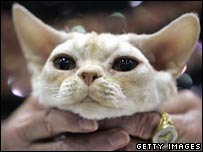
It takes 24 cats to make a coat
|
Steps to ban trade in cat and dog fur across the EU have been announced by the European Commission. The move follows a request for action from EU member states, and a campaign by Paul McCartney and his estranged wife, Heather Mills McCartney.
It is estimated that two million cats and dogs are being killed in China by fur traders each year.
Fifteen EU states have already taken some action on cat and dog fur, but it is still legal in the other 10.
 |
CAT AND DOG FUR TRADE
Campaigners claim 2 million cats and dogs slaughtered every year
Main exporter: China
12 to 15 adult dogs needed to make a dog fur coat
Up to 24 cats needed for cat fur coat
Cat and dog fur also used in hats, gloves, shoes, blankets, stuffed animals and toys
Dog fur sometimes labelled as: Gae-wolf, sobaki, Asian jackal, goupee, loup d'Asie, Corsac fox, dogues du Chine, or simply fake or exotic fur
Cat fur sometimes labelled as: house cat, wild cat, katzenfelle, rabbit, goyangi, mountain cat
|
"The message that we have received from EU consumers has been loud and clear. They do not find it acceptable to farm cats and dogs for their fur, nor do they want products containing such fur sold on the European market," said Commissioner for Health and Consumer Protection, Markos Kyprianou. The Commission says that different countries have taken different approaches to banning cat and dog fur, such as bans on rearing cats and dogs for fur, trade or import bans, and compulsory labelling.
It says the different legal requirements in each country could fragment the internal market for fur, so a co-ordinated approach is necessary.
The Commission's plan aims to:
- Block cat and dog fur imports at the border
- Introduce penalties for traders
- Encourage sharing of information on how to detect cat and dog fur.
The Commission says there is no evidence that cats and dogs are being bred for their fur inside the EU.
It says the obligation on member states to carry out checks and test for the fur will also provide a clearer picture of what products it is being used in, and where it comes from.
As cat and dog fur can be hard to detect when it is dyed, some states are already using hi-tech systems - mass spectrometry or DNA testing - to identify it.
A study commissioned by Dutch animal protection organisation Bont voor Dieren (Fur for Animals) in 2002 found canine DNA in five out of 93 fur items studied.


~RS~q~RS~~RS~z~RS~32~RS~)